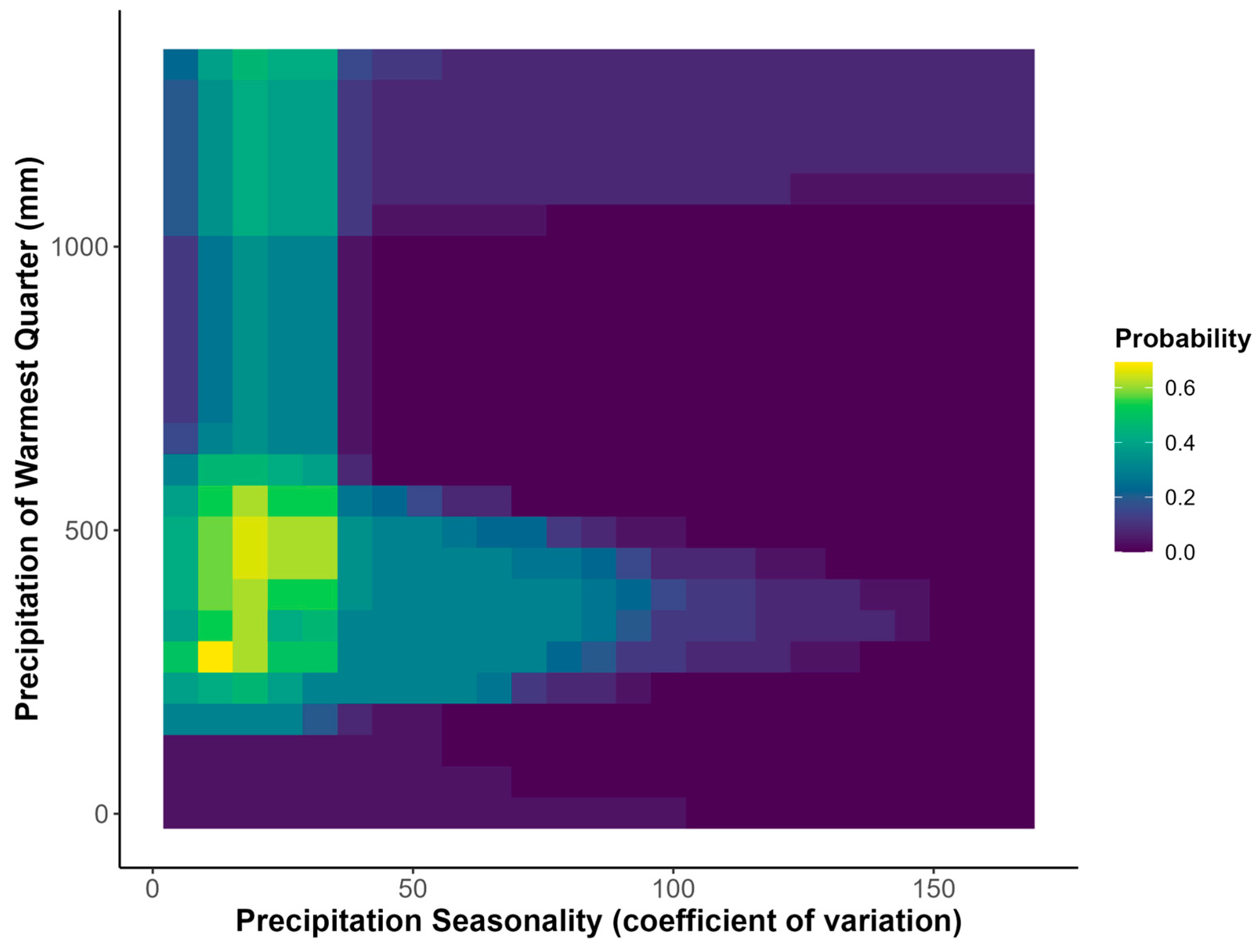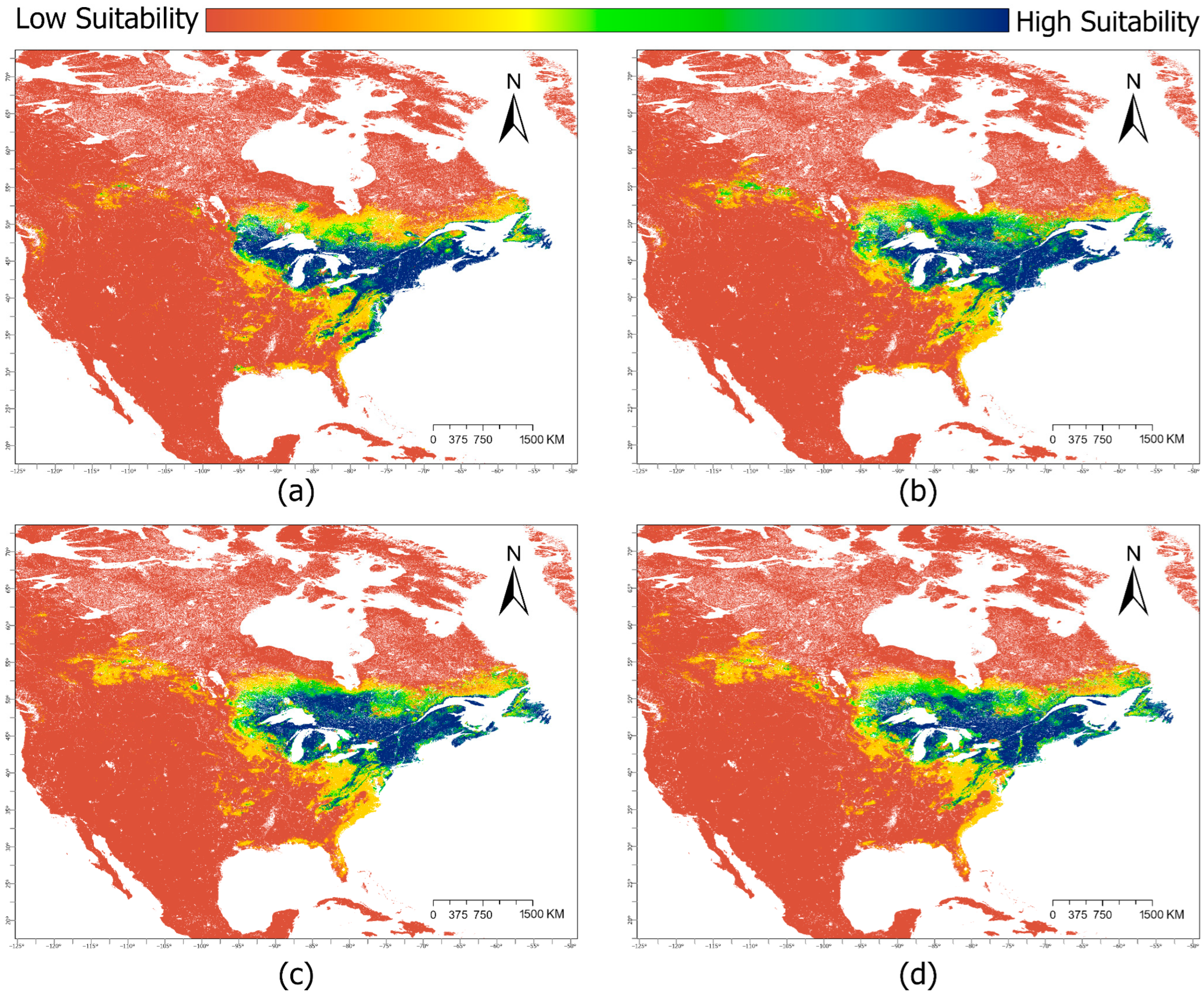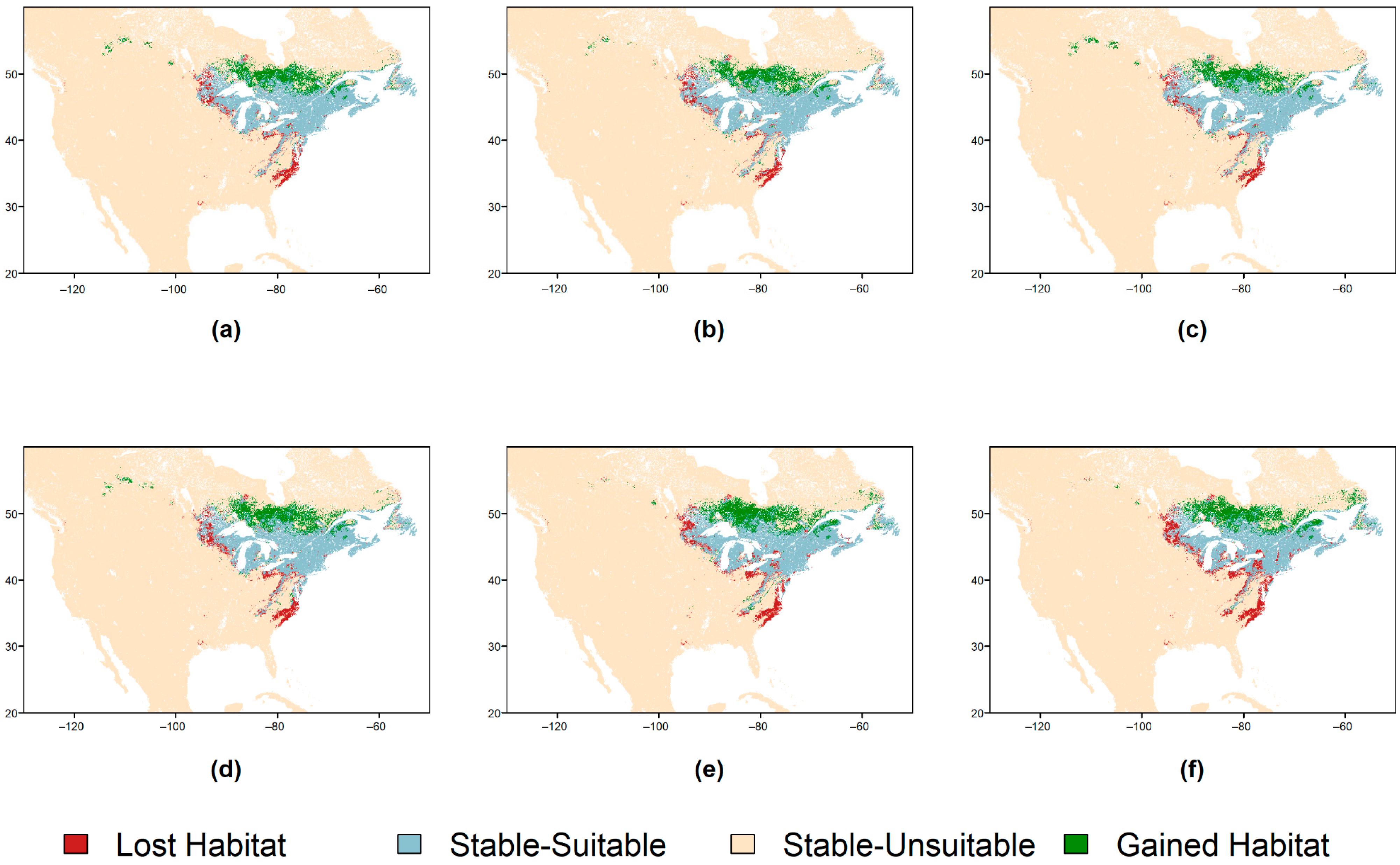Predicting Rapid, Climate-Driven Shifts in North American Habitat Suitability for the Purple Pitcher Plant (Sarracenia purpurea L.)
Abstract
1. Introduction
2. Results
2.1. Model Evaluation and Selection
2.2. Environmental Variable Selection
2.3. Habitat Suitability and Environmental Drivers
2.4. Future Habitat Suitability
3. Discussion
4. Materials and Methods
Supplementary Materials
Author Contributions
Funding
Data Availability Statement
Acknowledgments
Conflicts of Interest
Abbreviations
| HSM | Habitat Suitability Model |
| GBIF | Global Biodiversity Information Facility |
| SSP | Shared Socioeconomic Pathway |
| VIF | Variance Inflation Factor |
| GLM | Generalized Linear Model |
| RF | Random Forest |
| GBM | Gradient Boosted Machine/Generalized Boosted Model |
| TSS | True Skill Statistic |
| ROC | Area under the Receiver Operating Characteristic curve |
References
- Huntley, B. How Plants Respond to Climate Change: Migration Rates, Individualism and the Consequences for Plant Communities. Ann. Bot. 1991, 67, 15–22. [Google Scholar] [CrossRef]
- Parmesan, C. Ecological and Evolutionary Responses to Recent Climate Change. Annu. Rev. Ecol. Evol. Syst. 2006, 37, 637–669. [Google Scholar] [CrossRef]
- Abbass, K.; Qasim, M.Z.; Song, H.; Murshed, M.; Mahmood, H.; Younis, I. A review of the global climate change impacts, adaptation, and sustainable mitigation measures. Environ. Sci. Pollut. Res. 2022, 29, 42539–42559. [Google Scholar] [CrossRef]
- Pitelka, L.F.; Plant Migration Workshop Group. Plant Migration and Climate Change: A more realistic portrait of plant migration is essential to predicting biological responses to global warming in a world drastically altered by human activity. Am. Sci. 1997, 85, 464–473. [Google Scholar]
- Zhu, K.; Woodall, C.W.; Clark, J.S. Failure to migrate: Lack of tree range expansion in response to climate change. Glob. Change Biol. 2012, 18, 1042–1052. [Google Scholar] [CrossRef]
- Pecl, G.T.; Araújo, M.B.; Bell, J.D.; Blanchard, J.; Bonebrake, T.C.; Chen, I.-C.; Clark, T.D.; Colwell, R.K.; Danielsen, F.; Evengård, B.; et al. Biodiversity redistribution under climate change: Impacts on ecosystems and human well-being. Science 2017, 355, eaai9214. [Google Scholar] [CrossRef]
- Jump, A.S.; Peñuelas, J. Running to stand still: Adaptation and the response of plants to rapid climate change. Ecol. Lett. 2005, 8, 1010–1020. [Google Scholar] [CrossRef]
- Fitzpatrick, M.C.; Gove, A.D.; Sanders, N.J.; Dunn, R.R. Climate change, plant migration, and range collapse in a global biodiversity hotspot: The Banksia (Proteaceae) of Western Australia. Glob. Change Biol. 2008, 14, 1337–1352. [Google Scholar] [CrossRef]
- Vezzani, F.M.; Anderson, C.; Meenken, E.; Gillespie, R.; Peterson, M.; Beare, M.H. The importance of plants to development and maintenance of soil structure, microbial communities and ecosystem functions. Soil Tillage Res. 2018, 175, 139–149. [Google Scholar] [CrossRef]
- Kelly, A.E.; Goulden, M.L. Rapid shifts in plant distribution with recent climate change. Proc. Natl. Acad. Sci. USA 2008, 105, 11823–11826. [Google Scholar] [CrossRef] [PubMed]
- Parmesan, C.; Hanley, M.E. Plants and climate change: Complexities and surprises. Ann. Bot. 2015, 116, 849–864. [Google Scholar] [CrossRef]
- Thuiller, W.; Lavorel, S.; Araújo, M.B. Niche properties and geographical extent as predictors of species sensitivity to climate change. Glob. Ecol. Biogeogr. 2005, 14, 347–357. [Google Scholar] [CrossRef]
- Damschen, E.I.; Harrison, S.; Ackerly, D.D.; Fernandez-Going, B.M.; Anacker, B.L. Endemic plant communities on special soils: Early victims or hardy survivors of climate change? J. Ecol. 2012, 100, 1122–1130. [Google Scholar] [CrossRef]
- Corlett, R.T.; Tomlinson, K.W. Climate Change and Edaphic Specialists: Irresistible Force Meets Immovable Object? Trends Ecol. Evol. 2020, 35, 367–376. [Google Scholar] [CrossRef] [PubMed]
- Bu, Z.; Hans, J.; Li, H.; Zhao, G.; Zheng, X.; Ma, J.; Zeng, J. The response of peatlands to climate warming: A review. Acta Ecol. Sin. 2011, 31, 157–162. [Google Scholar] [CrossRef]
- Bao, T.; Jia, G.; Xu, X. Warming enhances dominance of vascular plants over cryptogams across northern wetlands. Glob. Change Biol. 2022, 28, 4097–4109. [Google Scholar] [CrossRef] [PubMed]
- Gajewski, K.; Viau, A.; Sawada, M.; Atkinson, D.; Wilson, S. Sphagnum peatland distribution in North America and Eurasia during the past 21,000 years. Glob. Biogeochem. Cycles 2001, 15, 297–310. [Google Scholar] [CrossRef]
- Fluet-Chouinard, E.; Stocker, B.D.; Zhang, Z.; Malhotra, A.; Melton, J.R.; Poulter, B.; Kaplan, J.O.; Goldewijk, K.K.; Siebert, S.; Minayeva, T.; et al. Extensive global wetland loss over the past three centuries. Nature 2023, 614, 281–286. [Google Scholar] [CrossRef]
- Page, S.E.; Baird, A.J. Peatlands and Global Change: Response and Resilience. Annu. Rev. Environ. Resour. 2016, 41, 35–57. [Google Scholar] [CrossRef]
- Salimi, S.; Almuktar, S.A.A.A.N.; Scholz, M. Impact of climate change on wetland ecosystems: A critical review of experimental wetlands. J. Environ. Manag. 2021, 286, 112160. [Google Scholar] [CrossRef]
- USGCRP. Fourth National Climate Assessment; U.S. Global Change Research Program: Washington, DC, USA, 2018; pp. 1–470.
- Mullens, E.; Shafer, M.; Hocker, J. Trends in heavy precipitation in the southern USA. Weather 2013, 68, 311–316. [Google Scholar] [CrossRef]
- Bell, M.C.; Ritson, J.P.; Verhoef, A.; Brazier, R.E.; Templeton, M.R.; Graham, N.J.D.; Freeman, C.; Clark, J.M. Sensitivity of peatland litter decomposition to changes in temperature and rainfall. Geoderma 2018, 331, 29–37. [Google Scholar] [CrossRef]
- US EPA. Climate Change Indicators: U.S. and Global Temperature. Reports and Assessments. Available online: https://www.epa.gov/climate-indicators/climate-change-indicators-us-and-global-temperature (accessed on 27 June 2016).
- Portmann, R.W.; Solomon, S.; Hegerl, G.C. Spatial and seasonal patterns in climate change, temperatures, and precipitation across the United States. Proc. Natl. Acad. Sci. USA 2009, 106, 7324–7329. [Google Scholar] [CrossRef]
- Gotelli, N.J.; Ellison, A.M. Nitrogen Deposition and Extinction Risk in the Northern Pitcher Plant, Sarracenia purpurea. Ecology 2002, 83, 2758–2765. [Google Scholar] [CrossRef]
- Ellison, A.M.; Butler, E.D.; Hicks, E.J.; Naczi, R.F.C.; Calie, P.J.; Bell, C.D.; Davis, C.C. Phylogeny and Biogeography of the Carnivorous Plant Family Sarraceniaceae. PLoS ONE 2012, 7, e39291. [Google Scholar] [CrossRef] [PubMed]
- Ne’eman, G.; Ne’eman, R.; Ellison, A.M. Limits to reproductive success of Sarracenia purpurea (Sarraceniaceae). Am. J. Bot. 2006, 93, 1660–1666. [Google Scholar] [CrossRef] [PubMed]
- Ellison, A.M.; Parker, J.N. Seed dispersal and seedling establishment of Sarracenia purpurea (Sarraceniaceae). Am. J. Bot. 2006, 89, 1024–1026. [Google Scholar] [CrossRef]
- Gotsch, S.G.; Ellison, A.M. Seed Germination of the Northern Pitcher Plant, Sarracenia purpurea. Northeast. Nat. 1998, 5, 175–182. [Google Scholar] [CrossRef]
- Aerts, R.; Cornelissen, J.H.C.; Dorrepaal, E.; Van Logtestijn, R.S.P.; Callaghan, T.V. Effects of experimentally imposed climate scenarios on flowering phenology and flower production of subarctic bog species. Glob. Change Biol. 2004, 10, 1599–1609. [Google Scholar] [CrossRef]
- Inouye, D.W. Climate change and phenology. WIREs Clim. Change 2022, 13, e764. [Google Scholar] [CrossRef]
- Shrestha, N. Detecting multicollinearity in regression analysis. Am. J. Appl. Math. Stat. 2020, 8, 39–42. [Google Scholar] [CrossRef]
- Vitt, P.; Taylor, A.; Rakosy, D.; Kreft, H.; Meyer, A.; Weigelt, P.; Knight, T.M. Global conservation prioritization for the Orchidaceae. Sci. Rep. 2023, 13, 6718. [Google Scholar] [CrossRef] [PubMed]
- Wang, H.-H.; Wonkka, C.L.; Treglia, M.L.; Grant, W.E.; Smeins, F.E.; Rogers, W.E. Species distribution modelling for conservation of an endangered endemic orchid. AoB Plants 2015, 7, plv039. [Google Scholar] [CrossRef]
- Abbott, M.J.; Battaglia, L.L. Purple Pitcher Plant (Sarracenia rosea) Dieback and Partial Community Disassembly following Experimental Storm Surge in a Coastal Pitcher Plant Bog. PLoS ONE 2015, 10, e0125475. [Google Scholar] [CrossRef] [PubMed]
- Nicholls, R.J.; Leatherman, S.P. Adapting to sea-level rise: Relative sea-level trends to 2100, for the United States. Coast. Manag. 1996, 24, 301–324. [Google Scholar] [CrossRef]
- Ellison, A.M.; Adamec, L. Carnivorous Plants: Physiology, Ecology, and Evolution; Oxford University Press: Oxford, UK, 2018. [Google Scholar]
- Zegeye, H. In situ and ex situ conservation: Complementary approaches for maintaining biodiversity. Int. J. Res. Environ. Stud. 2017, 4, 1–12. [Google Scholar]
- Wei, X.; Jiang, M. Meta-analysis of genetic representativeness of plant populations under ex situ conservation in contrast to wild source populations. Conserv. Biol. 2021, 35, 12–23. [Google Scholar] [CrossRef]
- Fleischmann, A.; München, B.S.; GeoBio-Center, L.M.U. Carnivorous plants and conservation—The role of carnivorous plant enthusiasts. Carniv. Plant Newsl. 2018, 52, 85–105. [Google Scholar] [CrossRef]
- Zhu, J.; Sun, G.; Li, W.; Zhang, Y.; Miao, G.; Noormets, A.; McNulty, S.G.; King, J.S.; Kumar, M.; Wang, X. Modeling the potential impacts of climate change on the water table level of selected forested wetlands in the southeastern United States. Hydrol. Earth Syst. Sci. 2017, 21, 6289–6305. [Google Scholar] [CrossRef]
- Guisan, A.; Thuiller, W.; Zimmerman, N.E. Habitat Suitability and Distribution Models with Applications in R; Cambridge University Press: Cambridge, UK, 2017. [Google Scholar]
- Guisan, A.; Thuiller, W. Predicting species distribution: Offering more than simple habitat models. Ecol. Lett. 2005, 8, 993–1009. [Google Scholar] [CrossRef]
- Thuiller, W.; Georges, D.; Gueguen, M.; Engler, R.; Breiner, F.; Lafourcade, B.; Patin, R.; Blancheteau, H. Biomod2: Ensemble Platform for Species Distribution Modeling. R Package Version 4.2-5-2. 2024. Available online: https://github.com/biomodhub/biomod2 (accessed on 15 June 2024).
- Thuiller, W.; Lafourcade, B.; Engler, R.; Araújo, M.B. BIOMOD—A platform for ensemble forecasting of species distributions. Ecography 2009, 32, 369–373. [Google Scholar] [CrossRef]
- GBIF.org. GBIF Occurrence Download. Available online: https://doi.org/10.15468/dl.zkxwt4 (accessed on 11 May 2023).
- Telenius, A. Biodiversity information goes public: GBIF at your service. Nord. J. Bot. 2011, 29, 378–381. [Google Scholar] [CrossRef]
- Aiello-Lammens, M.E.; Boria, R.A.; Radosavljevic, A.; Vilela, B.; Anderson, R.P. spThin: An R package for spatial thinning of species occurrence records for use in ecological niche models. Ecography 2015, 38, 541–545. [Google Scholar] [CrossRef]
- Barbet-Massin, M.; Jiguet, F.; Albert, C.H.; Thuiller, W. Selecting pseudo-absences for species distribution models: How, where and how many? Methods Ecol. Evol. 2012, 3, 327–338. [Google Scholar] [CrossRef]
- Hijmans, R.J.; Cameron, S.E.; Parra, J.L.; Jones, P.G.; Jarvis, A. Very high resolution interpolated climate surfaces for global land areas. Int. J. Climatol. A J. R. Meteorol. Soc. 2005, 15, 1965–1978. [Google Scholar] [CrossRef]
- Poggio, L.; de Sousa, L.M.; Batjes, N.H.; Heuvelink, G.B.M.; Kempen, B.; Ribeiro, E.; Rossiter, D. SoilGrids 2.0: Producing soil information for the globe with quantified spatial uncertainty. Soil 2021, 7, 217–240. [Google Scholar] [CrossRef]
- Commission for Environmental Cooperation (CEC). North American Environmental Atlas—Land Cover 2020 30m. North American Land Change Monitoring System. Canada Centre for Remote Sensing (CCRS), U.S. Geological Survey (USGS), Comisión Nacional para el Conocimiento y Uso de la Biodiversidad (CONABIO), Comisión Nacional Forestal (CONAFOR), Instituto Nacional de Estadística y Geografía (INEGI). Ed. 2.0, Raster Digital Data [30-m]. 2024. Available online: https://www.cec.org/north-american-environmental-atlas/land-cover-30m-2020/ (accessed on 2 October 2025).
- O’brien, R.M. A Caution Regarding Rules of Thumb for Variance Inflation Factors. Qual. Quant. 2007, 41, 673–690. [Google Scholar] [CrossRef]
- Breiman, L. Random forests. Mach. Learn. 2001, 45, 5–32. [Google Scholar] [CrossRef]
- Elith, J.; Ferrier, S.; Huettmann, F.; Leathwick, J. The evaluation strip: A new and robust method for plotting predicted responses from species distribution models. Ecol. Model. 2005, 186, 280–289. [Google Scholar] [CrossRef]
- Landis, R.J.; Koch, G.G. An Application of Hierarchical Kappa-type Statistics in the Assessment of Majority Agreement among Multiple Observers. Biometrics 1977, 33, 363–374. [Google Scholar] [CrossRef] [PubMed]
- Allouche, O.; Tsoar, A.; Kadmon, R. Assessing the accuracy of species distribution models: Prevalence, kappa and the true skill statistic (TSS). J. Appl. Ecol. 2006, 43, 1223–1232. [Google Scholar] [CrossRef]
- Brown, C.H.; Griscom, H.P. Differentiating between distribution and suitable habitat in ecological niche models: A red spruce (Picea rubens) case study. Ecol. Model. 2022, 472, 110102. [Google Scholar] [CrossRef]





| Variable Code | Variable Description | Mean Importance | Standard Deviation |
|---|---|---|---|
| PrecipWarmQ | Precipitation of the Warmest Quarter | 0.26 | <0.01 |
| PrecipSeasonality | Precipitation Seasonality (coefficient of variation) | 0.09 | <0.01 |
| MeanTempDryQ | Mean Temperature of the Driest Quarter (°C) | 0.09 | <0.01 |
| MeanDiurnalRange | Mean Diurnal Range (°C) | 0.07 | <0.01 |
| bdod_1530_mean | Bulk Density of the Fine Earth Fraction (cg/cm3) | 0.06 | <0.01 |
| phh2o_1530_mean | Soil pH (pH × 10) | 0.03 | <0.01 |
| PrecipColdQ | Precipitation of the Coldest Quarter (mm) | 0.03 | < 0.01 |
| clay_1530_mean | Proportion of Clay Particles (<0.0002 mm) in the Fine Earth Fraction (g/kg) | 0.02 | <0.01 |
| cec_1530_mean | Cation Exchange Capacity of the Soil (mmol(c)/kg) | 0.02 | <0.01 |
| cfvo_1530_mean | Volumetric fraction of coarse fragments (cm3/dm3, volume %) | 0.02 | <0.01 |
| MeanTempWetQ | Mean Temperature of the Wettest Quarter (°C) | 0.02 | <0.01 |
| ocs_1530_mean | Organic Carbon Stock (t/ha) | 0.02 | <0.01 |
| silt_1530_mean | Proportion of Silt Particles (≥0.002 mm and ≤0.05/0.063 mm) | 0.01 | <0.01 |
| N_1530_mean | Total Nitrogen (N) (cg/kg) | 0.01 | <0.01 |
| soc_1530_mean | Soil Organic Carbon Content in the Fine Earth Fraction (dg/kg) | 0.003 | <0.01 |
| Scenario | Loss | Gain | Range Change | Total Area (Million km2) |
|---|---|---|---|---|
| Baseline Climate | - | - | - | 14.09 |
| SSP 1–2.6 2040 | 12.90% | 26.19% | 13.29% | 15.39 |
| SSP 1–2.6 2100 | 14.44% | 28.24% | 13.80% | 15.37 |
| SSP 3–7.0 2040 | 12.47% | 25.07% | 12.61% | 15.33 |
| SSP 3–7.0 2100 | 16.51% | 31.56% | 15.05% | 15.54 |
| SSP 5–8.5 2040 | 11.79% | 25.93% | 14.14% | 15.52 |
| SSP 5–8.5 2100 | 21.17% | 31.08% | 9.91% | 14.58 |
Disclaimer/Publisher’s Note: The statements, opinions and data contained in all publications are solely those of the individual author(s) and contributor(s) and not of MDPI and/or the editor(s). MDPI and/or the editor(s) disclaim responsibility for any injury to people or property resulting from any ideas, methods, instructions or products referred to in the content. |
© 2025 by the authors. Licensee MDPI, Basel, Switzerland. This article is an open access article distributed under the terms and conditions of the Creative Commons Attribution (CC BY) license (https://creativecommons.org/licenses/by/4.0/).
Share and Cite
Brown, C.H.; Frick, B.L.; Mohan, J.E. Predicting Rapid, Climate-Driven Shifts in North American Habitat Suitability for the Purple Pitcher Plant (Sarracenia purpurea L.). Plants 2025, 14, 3337. https://doi.org/10.3390/plants14213337
Brown CH, Frick BL, Mohan JE. Predicting Rapid, Climate-Driven Shifts in North American Habitat Suitability for the Purple Pitcher Plant (Sarracenia purpurea L.). Plants. 2025; 14(21):3337. https://doi.org/10.3390/plants14213337
Chicago/Turabian StyleBrown, Christian H., Benjamin L. Frick, and Jacqueline E. Mohan. 2025. "Predicting Rapid, Climate-Driven Shifts in North American Habitat Suitability for the Purple Pitcher Plant (Sarracenia purpurea L.)" Plants 14, no. 21: 3337. https://doi.org/10.3390/plants14213337
APA StyleBrown, C. H., Frick, B. L., & Mohan, J. E. (2025). Predicting Rapid, Climate-Driven Shifts in North American Habitat Suitability for the Purple Pitcher Plant (Sarracenia purpurea L.). Plants, 14(21), 3337. https://doi.org/10.3390/plants14213337






